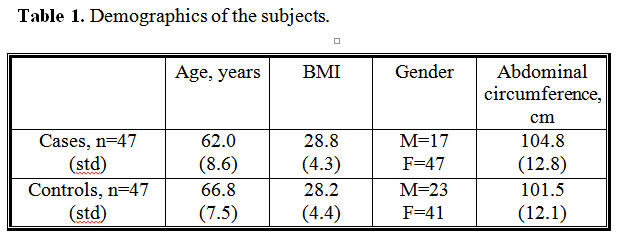Session Information
Session Type: Abstract Submissions (ACR)
Background/Purpose:
Knee Osteoarthritis (OA) is the most prevalent form of OA. Historically, not all people who have tell-tale signs of radiographic knee osteoarthritis progress to symptomatic knee osteoarthritis, and vice versa. According to a meta-analysis by Bedson et. al, the prevalence of radiographic knee OA (Rad OA) in symptomatic patients can range between 15-76%. However, Duncan et. al observed a strong correlation between increased symptoms and radiographic OA findings. Such inconsistencies may be resolved with a better understanding of the risk factors for symptomatic knee OA. To date, there has been no survey of risk factors involved in the progression of baseline asymptomatic Rad OA to symptomatic Rad OA (Symp OA). Therefore, we evaluated the abilities of various physical exam measures and demographical variables in predicting such progression over five years.
Methods:
Data from the Knee Osteoarthritis Initiative (OAI), a prospective longitudinal study of biomarkers involved in the onset and progression of OA in nearly 5000 subjects, were used for this study. Inclusion criteria were individuals who had Rad OA—score ≥ 2 on the Kellgren/Lawrence (K-L)—at baseline. The cases progressed to develop Symp OA—knee pain on most days of the month over the last 12 months—at 3 years, and remained symptomatic at 4 and 5 years, while the controls remained asymptomatic at all three time points from baseline. Cases and controls were matched for baseline knee K-L score, presence of unilateral or bilateral index knees and consistency of symptoms at all three time points (3, 4, and 5 years). The predictor variables were age, gender, BMI, abdominal circumference, walking ability (20m and 400m walk times), chair stands time, presence of Hand OA, varus/valgus malalignment, medial and lateral joint line tenderness, knee flexion pain, flexion contracture or hyperextension sign, bulge sign, patellar tap sign and isometric quadriceps strength corrected for body weight. Univariate conditional logistic regression was performed and p-values, odds ratios and 95 %confidence intervals were calculated.
Results:
The baseline sample included 2093 individuals with Rad OA (K-L ≥ 2). The matching process yielded 94 cases and controls, with similar demographic data (Table 1). Logistic regression analysis revealed that age (p=0.04), medial joint line tenderness (p=0.008), lateral joint line tenderness (p=0.01) and knee flexion pain (p=0.047) were significant predictor variables. 95% confidence intervals were >1 and odds ratios were >1 for the four significant variables.
Conclusion:
Age, knee flexion pain, medial and lateral joint line tenderness are measures with significant (p<0.05) predictive ability of progression from baseline Rad OA to Symp OA. As such, these commonly used demographic and physical exam measures can help physicians identify individuals with asymptomatic radiographic OA who may be at risk for developing chronic knee pain. Ultimately, older age and positive signs on these physical exam measures can serve as markers to initiate aggressive management to help prevent the onset of symptomatic knee OA.
Disclosure:
A. Gande,
None;
J. J. Irrgang,
None.
« Back to 2012 ACR/ARHP Annual Meeting
ACR Meeting Abstracts - https://acrabstracts.org/abstract/baseline-knee-flexion-pain-age-and-joint-line-tenderness-predict-the-progression-of-asymptomatic-radiographic-knee-osteoarthritis-to-symptomatic-knee-osteoarthritis-over-5-years/

